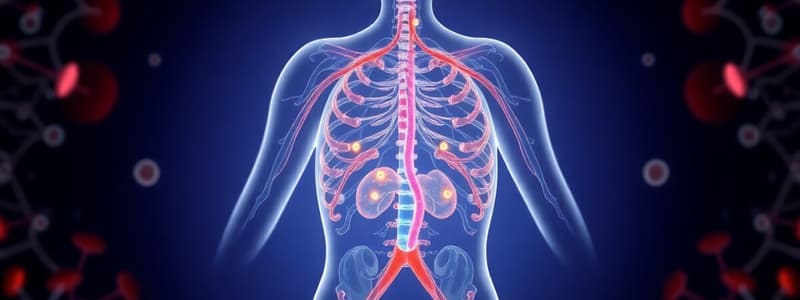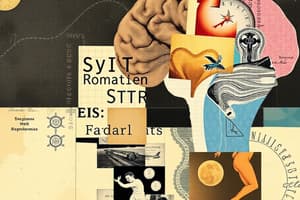Podcast
Questions and Answers
What is the primary difference between the nervous system and the endocrine system in terms of communication?
What is the primary difference between the nervous system and the endocrine system in terms of communication?
- The nervous system communicates chemically while the endocrine system communicates electrically.
- The endocrine system communicates chemically and is slower to respond but longer lasting than the nervous system. (correct)
- The nervous system is slower but longer lasting than the endocrine system.
- The endocrine system communicates quickly and transmits neurotransmitters.
Which of the following components is NOT part of the endocrine system?
Which of the following components is NOT part of the endocrine system?
- Nervous tissue (correct)
- Target or receptor organ
- Chemical messengers
- Host organ
What does the half-life of a hormone indicate?
What does the half-life of a hormone indicate?
- The duration before a hormone is fully eliminated from the body.
- The time required to reduce a hormone’s blood concentration by one half. (correct)
- The time it takes for a hormone to be synthesized.
- The maximum effect duration of a hormone.
How do most hormones circulate in the bloodstream?
How do most hormones circulate in the bloodstream?
What mechanism is commonly used for regulating hormone release?
What mechanism is commonly used for regulating hormone release?
During exercise, what primary function does the endocrine system serve?
During exercise, what primary function does the endocrine system serve?
How are hormones typically secreted in the body?
How are hormones typically secreted in the body?
Which term describes the length of time hormones exist in the bloodstream before reducing concentration?
Which term describes the length of time hormones exist in the bloodstream before reducing concentration?
What determines the extent of a target cell's activation by a hormone?
What determines the extent of a target cell's activation by a hormone?
Which mechanism describes how hormones exert their effects after binding to receptors?
Which mechanism describes how hormones exert their effects after binding to receptors?
What is a way hormones can alter cellular reactions in target cells?
What is a way hormones can alter cellular reactions in target cells?
How can the number of receptors for a hormone on a target cell be modified?
How can the number of receptors for a hormone on a target cell be modified?
What is an example of a second-messenger system that hormones can activate?
What is an example of a second-messenger system that hormones can activate?
Which of the following hormones can induce secretory activity?
Which of the following hormones can induce secretory activity?
What is the effect of the same hormone on different target organs?
What is the effect of the same hormone on different target organs?
Flashcards
Neuroendocrine System
Neuroendocrine System
A communication system that uses both electrical signals (nervous system) and chemical signals (endocrine system) to regulate bodily functions.
Endocrine System
Endocrine System
A system of glands that produce and release hormones into the bloodstream to regulate various bodily functions.
Hormone
Hormone
A chemical messenger produced by endocrine glands that travels through the bloodstream to target cells, influencing their activity.
Half-life of Hormone
Half-life of Hormone
Signup and view all the flashcards
What distinguishes endocrine from exocrine glands?
What distinguishes endocrine from exocrine glands?
Signup and view all the flashcards
How are hormones regulated in the body?
How are hormones regulated in the body?
Signup and view all the flashcards
What is the role of hormones in exercise?
What is the role of hormones in exercise?
Signup and view all the flashcards
How are endocrine and nervous systems linked?
How are endocrine and nervous systems linked?
Signup and view all the flashcards
Hormone-Receptor Complex
Hormone-Receptor Complex
Signup and view all the flashcards
Receptor Location
Receptor Location
Signup and view all the flashcards
Hormone Action: 'Lock and Key' Mechanism
Hormone Action: 'Lock and Key' Mechanism
Signup and view all the flashcards
Factors Influencing a Target Cell's Response
Factors Influencing a Target Cell's Response
Signup and view all the flashcards
Hormone Action: Changing Enzyme Activity
Hormone Action: Changing Enzyme Activity
Signup and view all the flashcards
Hormone Action: Second Messenger Systems
Hormone Action: Second Messenger Systems
Signup and view all the flashcards
Hormone Action: Diverse Effects
Hormone Action: Diverse Effects
Signup and view all the flashcards
Study Notes
Endocrine System Overview
- The neuroendocrine system is a communication system.
- The nervous system uses electrical signals and neurotransmitters.
- The endocrine system uses chemical messengers called hormones.
- Hormones are slower to respond but have longer-lasting effects than the nervous system.
- Hormones are chemical messengers synthesized, stored, and released by endocrine glands and certain other cells.
- The endocrine system consists of a host organ, small concentrations of chemical messengers, and a target/receptor organ.
- Hormones are chemical substances synthesized by specific host glands.
Hormone Half-Life
- Half-life is the time required to reduce a hormone's blood concentration by half.
- It indicates how long the hormonal effect lasts.
- Most hormones circulate in the blood, affecting distant tissues.
- Some hormones affect local areas of synthesis.
- Many hormones need transport proteins for transport (e.g., sex hormone-binding globulin).
- Hormone effects depend on receptor location. Only unbound (free) hormones interact with their receptors.
Endocrine System Function
- The endocrine system constantly monitors the internal environment and coordinates integration of physiological systems during rest and exercise.
- It maintains homeostasis via hormones, controlling and regulating cell and organ activity.
- During exercise it maintains homeostasis, controls substrate metabolism, and regulates fluid and electrolyte balance.
Hormone Release Patterns
- Most hormones respond to peripheral stimuli as needed.
- Hormones are released in bursts (pulsatile).
- Plasma hormone concentrations fluctuate over minutes, hours and days.
- Concentrations fluctuate over days/weeks.
- Hormone release is regulated by homeostasis. This includes negative feedback (like a thermostat) and positive feedback loops (e.g., oxytocin).
- Hormones are released at regular intervals following diurnal patterns or cycles.
Hormone Receptors
- Hormone binds to receptors to create a hormone-receptor complex (H-RC).
- Receptors can be on the cell surface or inside the cell.
- Hormones only affect tissues with specific receptors.
- Hormone effects occur after receptor binding.
- A typical cell has 2,000 to 10,000 receptors.
Hormone-Receptor Binding
- The "lock and key" mechanism is the first step in hormone action.
- The extent of target cell activation depends on:
- Hormone concentration in the blood.
- Available receptors on the target cell. (Receptors can be upregulated, downregulated, or saturated.)
- Affinity (or sensitivity) of hormone-receptor binding.
- Other chemical inhibitors (e.g., beta blockers).
Hormone-Target Cell Reactions
-
Hormones alter cellular reactions in specific target cells by:
- Changing enzyme activity rates.
- Modifying intracellular protein synthesis rates.
- Activating second-messenger systems (e.g., G-proteins, cAMP, and kinase reactions).
- Inducing secretory activity (e.g., growth hormone and insulin-like growth factors).
-
The same hormone can have different effects depending on the target organ.
-
Steroid hormones migrate into their target cells. Example include testosterone in skeletal muscle or dihydrotestosterone in sex-linked tissues.
Studying That Suits You
Use AI to generate personalized quizzes and flashcards to suit your learning preferences.




